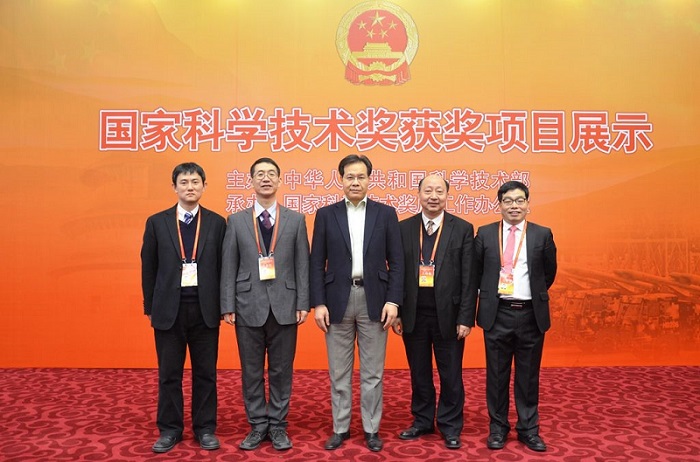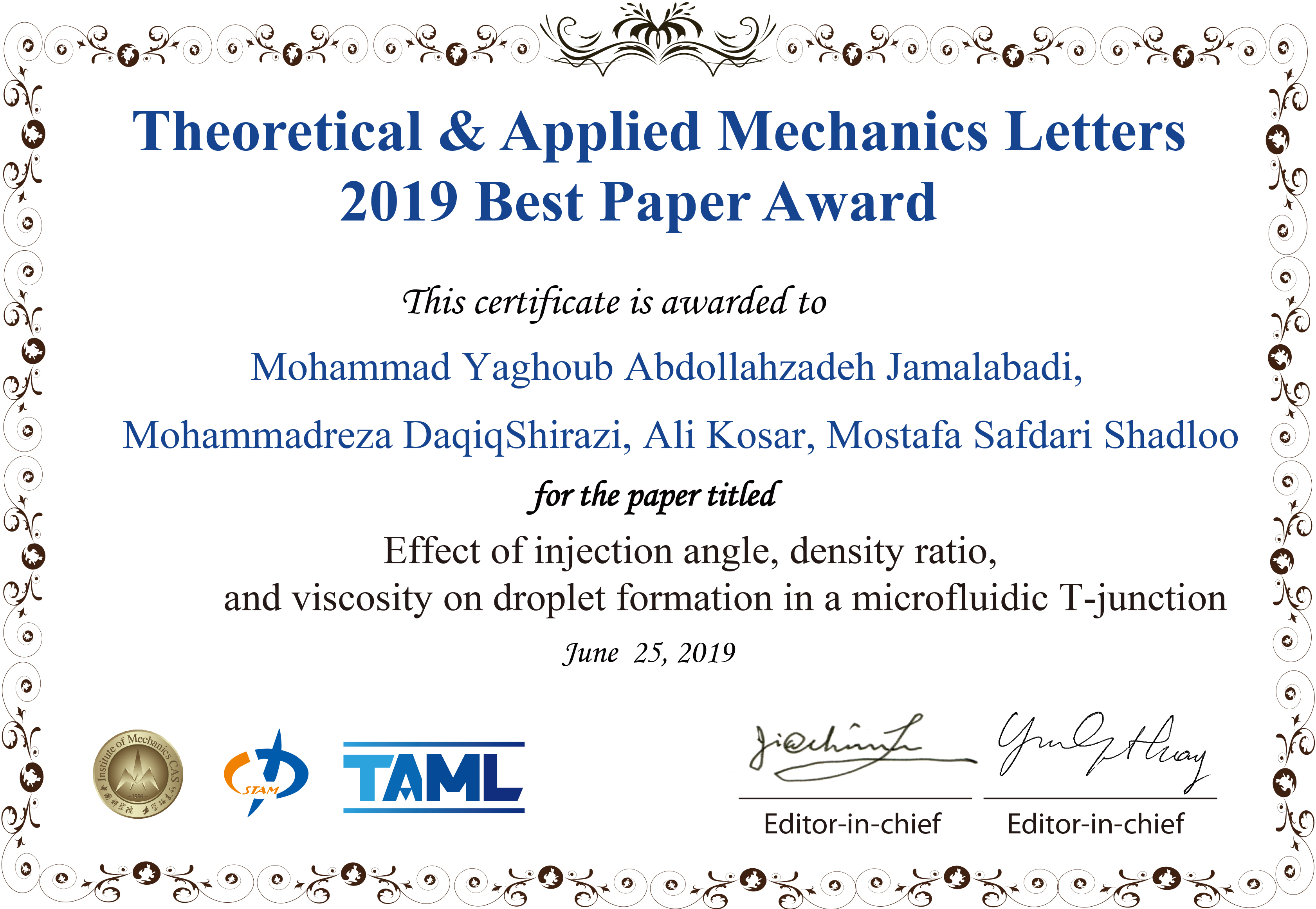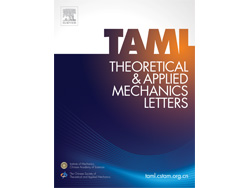Institute of Mechanics,
Chinese Academy of Sciences
2023 Vol.13(5)
Display Mode: |
Theoretical and Applied Mechanics Letters 13 (2023) 100470.
doi: 10.1016/j.taml.2023.100470
Abstract:
We consider the two-point, two-time (space-time) correlation of passive scalar R(r, τ) in the Kraichnan model under the assumption of homogeneity and isotropy. Using the fine-gird PDF method, we find that R(r, τ) satisfies a diffusion equation with constant diffusion coefficient determined by velocity variance and molecular diffusion. Its solution can be expressed in terms of the two-point, one time correlation of passive scalar, i.e.,. R(r, 0) Moreover, the decorrelation of Ȓ(k, τ), which is the Fourier transform of R(r, τ), is determined by Ȓ(k, 0) and a diffusion kernal.
We consider the two-point, two-time (space-time) correlation of passive scalar R(r, τ) in the Kraichnan model under the assumption of homogeneity and isotropy. Using the fine-gird PDF method, we find that R(r, τ) satisfies a diffusion equation with constant diffusion coefficient determined by velocity variance and molecular diffusion. Its solution can be expressed in terms of the two-point, one time correlation of passive scalar, i.e.,. R(r, 0) Moreover, the decorrelation of Ȓ(k, τ), which is the Fourier transform of R(r, τ), is determined by Ȓ(k, 0) and a diffusion kernal.
Theoretical and Applied Mechanics Letters 13 (2023) 100471.
doi: 10.1016/j.taml.2023.100471
Abstract:
This study proposes a cost-effective machine-learning based model for predicting velocity and turbulence kinetic energy fields in the wake of wind turbines for yaw control applications. The model consists of an auto-encoder convolutional neural network (ACNN) trained to extract the features of turbine wakes using instantaneous data from large-eddy simulation (LES). The proposed framework is demonstrated by applying it to the Sandia National Laboratory Scaled Wind Farm Technology facility consisting of three 225 kW turbines. LES of this site is performed for different wind speeds and yaw angles to generate datasets for training and validating the proposed ACNN. It is shown that the ACNN accurately predicts turbine wake characteristics for cases with turbine yaw angle and wind speed that were not part of the training process. Specifically, the ACNN is shown to reproduce the wake redirection of the upstream turbine and the secondary wake steering of the downstream turbine accurately. Compared to the brute-force LES, the ACNN developed herein is shown to reduce the overall computational cost required to obtain the steady state first and second-order statistics of the wind farm by about 85%.
This study proposes a cost-effective machine-learning based model for predicting velocity and turbulence kinetic energy fields in the wake of wind turbines for yaw control applications. The model consists of an auto-encoder convolutional neural network (ACNN) trained to extract the features of turbine wakes using instantaneous data from large-eddy simulation (LES). The proposed framework is demonstrated by applying it to the Sandia National Laboratory Scaled Wind Farm Technology facility consisting of three 225 kW turbines. LES of this site is performed for different wind speeds and yaw angles to generate datasets for training and validating the proposed ACNN. It is shown that the ACNN accurately predicts turbine wake characteristics for cases with turbine yaw angle and wind speed that were not part of the training process. Specifically, the ACNN is shown to reproduce the wake redirection of the upstream turbine and the secondary wake steering of the downstream turbine accurately. Compared to the brute-force LES, the ACNN developed herein is shown to reduce the overall computational cost required to obtain the steady state first and second-order statistics of the wind farm by about 85%.
Theoretical and Applied Mechanics Letters 13 (2023) 100472.
doi: 10.1016/j.taml.2023.100472
Abstract:
The computational cost of unsteady adjoint equations remains high in adjoint-based unsteady aerodynamic optimization. In this letter, the solution of unsteady adjoint equations is accelerated by dynamic mode decomposition (DMD). The pseudo-time marching of every real-time step is approximated as an infinite-dimensional linear dynamical system. Thereafter, DMD is utilized to analyze the adjoint vectors sampled from these pseudo-time marching. First-order zero frequency mode is selected to accelerate the pseudo-time marching of unsteady adjoint equations in every real-time step. Through flow past a stationary circular cylinder and an unsteady aerodynamic shape optimization example, the efficiency of solving unsteady adjoint equations is significantly improved. Results show that one hundred adjoint vectors contains enough information about the pseudo-time dynamics, and the adjoint dominant mode can be precisely predicted only by five snapshots produced from the adjoint vectors, which indicates DMD analysis for pseudo-time marching of unsteady adjoint equations is efficient.
The computational cost of unsteady adjoint equations remains high in adjoint-based unsteady aerodynamic optimization. In this letter, the solution of unsteady adjoint equations is accelerated by dynamic mode decomposition (DMD). The pseudo-time marching of every real-time step is approximated as an infinite-dimensional linear dynamical system. Thereafter, DMD is utilized to analyze the adjoint vectors sampled from these pseudo-time marching. First-order zero frequency mode is selected to accelerate the pseudo-time marching of unsteady adjoint equations in every real-time step. Through flow past a stationary circular cylinder and an unsteady aerodynamic shape optimization example, the efficiency of solving unsteady adjoint equations is significantly improved. Results show that one hundred adjoint vectors contains enough information about the pseudo-time dynamics, and the adjoint dominant mode can be precisely predicted only by five snapshots produced from the adjoint vectors, which indicates DMD analysis for pseudo-time marching of unsteady adjoint equations is efficient.
Theoretical and Applied Mechanics Letters 13 (2023) 100464.
doi: 10.1016/j.taml.2023.100464
Abstract:
Hypersonic vehicles suffer from extreme aerodynamic heating during flights, especially around the area of leading edge due to its small curvature. Therefore, flush air data sensing (FADS) system has been developed to perform accurate measurement of the air data parameters. In the present study, the method to develop the FADS algorithms with fail-operational capability for a sharp-nosed hypersonic vehicle is provided. To be specific, the FADS system implemented with 16 airframe-integrated pressure ports is used as a case study. Numerical simulations of different freestream conditions have been conducted to generate the database for the FADS targeting in 2 ≤Ma≤ 5 and 0 km ≤H≤ 30 km. Four groups of neural network algorithms have been developed based on four different pressure port configurations, and the accuracy has been validated by 280 groups of simulations. Particularly, the algorithms based on the 16-port configuration show an excellent ability to serve as the main solver of the FADS, where 99.5% of the angle-of-attack estimations are within the error band ±0.2°. The accuracy of the algorithms is discussed in terms of port configuration. Furthermore, diagnosis of the system health is present in the paper. A fault-tolerant FADS system architecture has been designed, which is capable of continuously sensing the air data in the case that multi-port failure occurs, with a reduction in the system accuracy.
Hypersonic vehicles suffer from extreme aerodynamic heating during flights, especially around the area of leading edge due to its small curvature. Therefore, flush air data sensing (FADS) system has been developed to perform accurate measurement of the air data parameters. In the present study, the method to develop the FADS algorithms with fail-operational capability for a sharp-nosed hypersonic vehicle is provided. To be specific, the FADS system implemented with 16 airframe-integrated pressure ports is used as a case study. Numerical simulations of different freestream conditions have been conducted to generate the database for the FADS targeting in 2 ≤Ma≤ 5 and 0 km ≤H≤ 30 km. Four groups of neural network algorithms have been developed based on four different pressure port configurations, and the accuracy has been validated by 280 groups of simulations. Particularly, the algorithms based on the 16-port configuration show an excellent ability to serve as the main solver of the FADS, where 99.5% of the angle-of-attack estimations are within the error band ±0.2°. The accuracy of the algorithms is discussed in terms of port configuration. Furthermore, diagnosis of the system health is present in the paper. A fault-tolerant FADS system architecture has been designed, which is capable of continuously sensing the air data in the case that multi-port failure occurs, with a reduction in the system accuracy.
Theoretical and Applied Mechanics Letters 13 (2023) 100473.
doi: 10.1016/j.taml.2023.100473
Abstract:
This paper presents a novel experiment to observe the whole water entry process of a free-falling sphere into a regular wave. A time-accurate synchronizing system modulates the moment elaborately to ensure the sphere impacting onto the water surface at the desirable wave phase. Four high-speed cameras focus locally to measure the high-precision size of the cavity evolution. Meanwhile, the aggregated field view of the camera array covers both the splash above the free surface and the entire cavity in the wave. The detailed methodologies are described and verified for the hardware set-up and the image post-processing. The theoretical maximum deviation is 1.7% on the space scale. The integral morphology of the cavity is captured precisely in the coordinate system during the sphere penetrates through the water at four representative wave phases and the still water. The result shows that the horizontal velocity of the fluid particle in the wave impels the cavity and changes the shape distinctly. Notably, the wave motion causes the cavity to pinch off earlier at the wave trough phase and later at the wave crest phase than in the still water. The wave motion influences the falling process of the sphere slightly in the present parameters.
This paper presents a novel experiment to observe the whole water entry process of a free-falling sphere into a regular wave. A time-accurate synchronizing system modulates the moment elaborately to ensure the sphere impacting onto the water surface at the desirable wave phase. Four high-speed cameras focus locally to measure the high-precision size of the cavity evolution. Meanwhile, the aggregated field view of the camera array covers both the splash above the free surface and the entire cavity in the wave. The detailed methodologies are described and verified for the hardware set-up and the image post-processing. The theoretical maximum deviation is 1.7% on the space scale. The integral morphology of the cavity is captured precisely in the coordinate system during the sphere penetrates through the water at four representative wave phases and the still water. The result shows that the horizontal velocity of the fluid particle in the wave impels the cavity and changes the shape distinctly. Notably, the wave motion causes the cavity to pinch off earlier at the wave trough phase and later at the wave crest phase than in the still water. The wave motion influences the falling process of the sphere slightly in the present parameters.
Theoretical and Applied Mechanics Letters 13 (2023) 100463.
doi: 10.1016/j.taml.2023.100463
Abstract:
In recent years, forest fires and maritime accidents have occurred frequently, which have had a bad impact on human production and life. Thus, the development of seaplanes is an increasingly urgent demand. It is important to study the taxiing process of seaplanes for the development of seaplanes, which is a strong nonlinear fluidstructure interaction problem. In this paper, the smoothed particle hydrodynamics (SPH) method based on the Lagrangian framework is utilized to simulate the taxiing process of seaplanes, and the SPH results are compared with those of the finite volume method (FVM) based on the Eulerian method. The results show that the SPH method can not only give the same accuracy as the FVM but also have a strong ability to capture the splashing waves in the taxiing process, which is quite meaningful for the subsequent study of the effect of a splash on other parts of the seaplane.
In recent years, forest fires and maritime accidents have occurred frequently, which have had a bad impact on human production and life. Thus, the development of seaplanes is an increasingly urgent demand. It is important to study the taxiing process of seaplanes for the development of seaplanes, which is a strong nonlinear fluidstructure interaction problem. In this paper, the smoothed particle hydrodynamics (SPH) method based on the Lagrangian framework is utilized to simulate the taxiing process of seaplanes, and the SPH results are compared with those of the finite volume method (FVM) based on the Eulerian method. The results show that the SPH method can not only give the same accuracy as the FVM but also have a strong ability to capture the splashing waves in the taxiing process, which is quite meaningful for the subsequent study of the effect of a splash on other parts of the seaplane.
Theoretical and Applied Mechanics Letters 13 (2023) 100462.
doi: 10.1016/j.taml.2023.100462
Abstract:
The effect of gravity on the self-similarity of jet shape at late stage of Worthington jet development is investigated by experiment in the study. In addition, the particle image velocimetry (PIV) method is introduced to analyze the development of flow field. There is a linear scaling regarding the axial velocity of the jet and the scaling coefficient increases with the Froude number.
The effect of gravity on the self-similarity of jet shape at late stage of Worthington jet development is investigated by experiment in the study. In addition, the particle image velocimetry (PIV) method is introduced to analyze the development of flow field. There is a linear scaling regarding the axial velocity of the jet and the scaling coefficient increases with the Froude number.
Theoretical and Applied Mechanics Letters 13 (2023) 100474.
doi: 10.1016/j.taml.2023.100474
Abstract:
A computational fluid dynamics (CFD) solver for a GPU/CPU heterogeneous architecture parallel computing platform is developed to simulate incompressible flows on billion-level grid points. To solve the Poisson equation, the conjugate gradient method is used as a basic solver, and a Chebyshev method in combination with a Jacobi sub-preconditioner is used as a preconditioner. The developed CFD solver shows good performance on parallel efficiency, which exceeds 90% in the weak-scalability test when the number of grid points allocated to each GPU card is greater than 2083. In the acceleration test, it is found that running a simulation with 10403 grid points on 125 GPU cards accelerates by 203.6x over the same number of CPU cores. The developed solver is then tested in the context of a two-dimensional lid-driven cavity flow and three-dimensional Taylor-Green vortex flow. The results are consistent with previous results in the literature.
A computational fluid dynamics (CFD) solver for a GPU/CPU heterogeneous architecture parallel computing platform is developed to simulate incompressible flows on billion-level grid points. To solve the Poisson equation, the conjugate gradient method is used as a basic solver, and a Chebyshev method in combination with a Jacobi sub-preconditioner is used as a preconditioner. The developed CFD solver shows good performance on parallel efficiency, which exceeds 90% in the weak-scalability test when the number of grid points allocated to each GPU card is greater than 2083. In the acceleration test, it is found that running a simulation with 10403 grid points on 125 GPU cards accelerates by 203.6x over the same number of CPU cores. The developed solver is then tested in the context of a two-dimensional lid-driven cavity flow and three-dimensional Taylor-Green vortex flow. The results are consistent with previous results in the literature.
Theoretical and Applied Mechanics Letters 13 (2023) 100459.
doi: 10.1016/j.taml.2023.100459
Abstract:
An innovative local artificial boundary condition is proposed to numerically solve the Cauchy problem of the Klein-Gordon equation in an unbounded domain. Initially, the equation is considered as the axial wave propagation in a bar supported on a spring foundation. The numerical model is then truncated by replacing the half-infinitely long bar with an equivalent mechanical structure. The effective frequency-dependent stiffness of the half-infinitely long bar is expressed as the sum of rational terms using Pade approximation. For each term, a corresponding substructure composed of dampers and masses is constructed. Finally, the equivalent mechanical structure is obtained by parallelly connecting these substructures. The proposed approach can be easily implemented within a standard finite element framework by incorporating additional mass points and damper elements. Numerical examples show that with just a few extra degrees of freedom, the proposed approach effectively suppresses artificial reflections at the truncation boundary and exhibits first-order convergence.
An innovative local artificial boundary condition is proposed to numerically solve the Cauchy problem of the Klein-Gordon equation in an unbounded domain. Initially, the equation is considered as the axial wave propagation in a bar supported on a spring foundation. The numerical model is then truncated by replacing the half-infinitely long bar with an equivalent mechanical structure. The effective frequency-dependent stiffness of the half-infinitely long bar is expressed as the sum of rational terms using Pade approximation. For each term, a corresponding substructure composed of dampers and masses is constructed. Finally, the equivalent mechanical structure is obtained by parallelly connecting these substructures. The proposed approach can be easily implemented within a standard finite element framework by incorporating additional mass points and damper elements. Numerical examples show that with just a few extra degrees of freedom, the proposed approach effectively suppresses artificial reflections at the truncation boundary and exhibits first-order convergence.
Theoretical and Applied Mechanics Letters 13 (2023) 100476.
doi: 10.1016/j.taml.2023.100476
Abstract:
Researchers have proposed various linkage mechanisms to connect knee and ankle joints for above-knee prostheses, but most of them only offer natural walking. However, studies have shown that people assume a squatting posture during daily activities. This paper introduces a novel mechanism that connects the knee joint with the foot-ankle joint to enable both squatting and walking. The prosthetic knee used is the well-known 3R36, while the energy storing and return (ESAR) prosthetic foot is used for the ankle-foot joint. To coordinate knee and ankle joint movements, a six-bar linkage mechanism structure is proposed. Simulation results demonstrate that the proposed modular transfemoral prosthesis accurately mimics the motion patterns of a natural human leg during walking and squatting. For instance, the prosthesis allows a total knee flexion of more than 140° during squatting. The new prosthesis design also incorporates energy-storing mechanisms to reduce energy expenditure during walking for amputees.
Researchers have proposed various linkage mechanisms to connect knee and ankle joints for above-knee prostheses, but most of them only offer natural walking. However, studies have shown that people assume a squatting posture during daily activities. This paper introduces a novel mechanism that connects the knee joint with the foot-ankle joint to enable both squatting and walking. The prosthetic knee used is the well-known 3R36, while the energy storing and return (ESAR) prosthetic foot is used for the ankle-foot joint. To coordinate knee and ankle joint movements, a six-bar linkage mechanism structure is proposed. Simulation results demonstrate that the proposed modular transfemoral prosthesis accurately mimics the motion patterns of a natural human leg during walking and squatting. For instance, the prosthesis allows a total knee flexion of more than 140° during squatting. The new prosthesis design also incorporates energy-storing mechanisms to reduce energy expenditure during walking for amputees.
 Submit a Paper
Submit a Paper
 Subscription
Subscription
News
MORE+
Call for Papers
MORE+
- Crossing-Mechanics Driven by Big Data
- Machine learning in the fluid mechanics research of wind energy
- Mechanics of Origami/Kirigami structures and metamaterials
- New insights and perspectives on impact biomechanics for human tissues: from injury prevention, protection to protective equipment
- Environmental Mechanics for Extreme Natural Events














